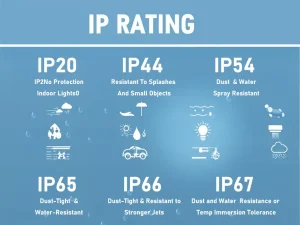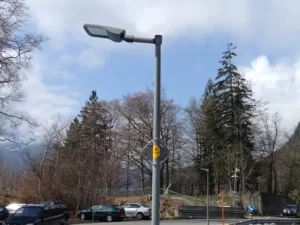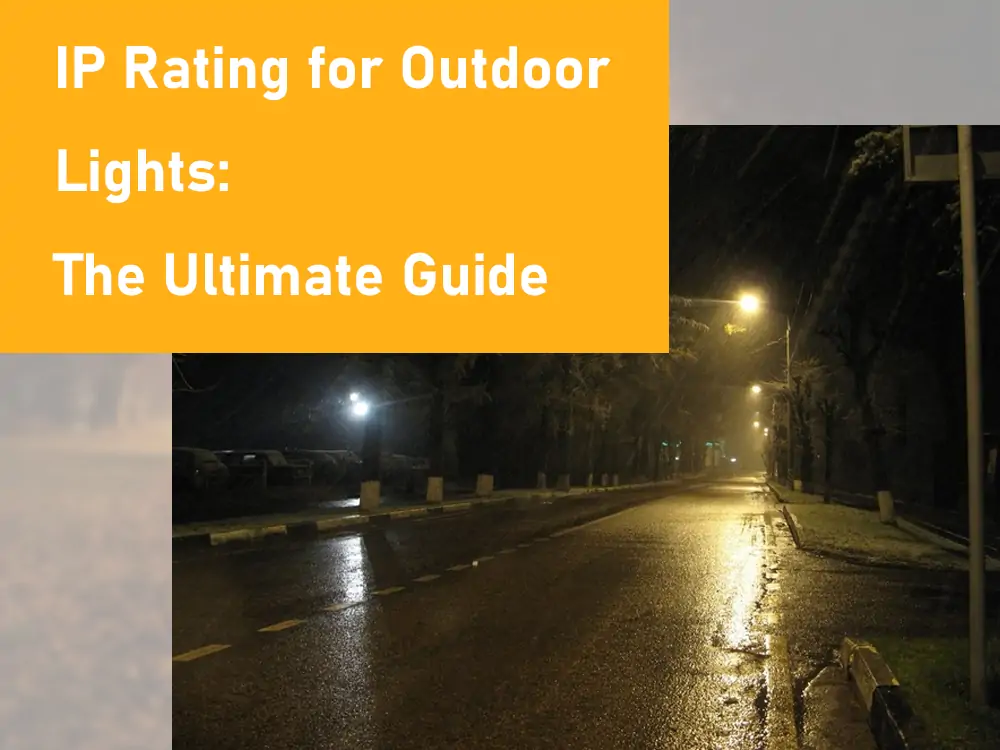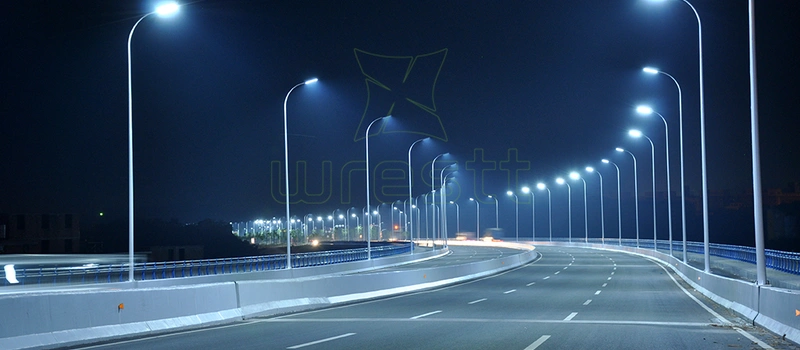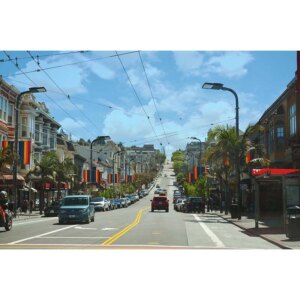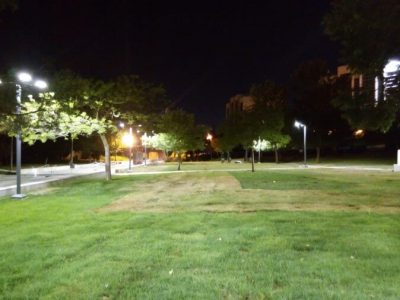Introduction:
Outdoor lights require protection from dust, water, and weather changes to function properly. The IP rating for outdoor lights gives us an idea of how safe a light is from these things. It has two numbers—one for dust and one for water. The higher the number, the better the protection.
The first number indicates how well the light is sealed against solid elements such as dust. It can be from 0 to 6. The higher the number, the better the light is at keeping dust out. The second number indicates how waterproof the light is. This number may be anywhere between 0 and 9. The higher the number, the more water the light can handle without damage.
Understanding the IP Ratings for Outdoor Lights
If the light is exposed to harsh conditions or damage, it can fail to work. Lights in rainy places need better water-resistant protection, while those in dusty places require strong dust protection. Good IP ratings ensure the light’s longer-lasting and safe operation.
Outdoor lights need maintenance. Keeping them well-cleaned and checking for potential damage can help them work. A broken light may not effectively block out water or dust. Tread safely with outdoor spaces in mind by always choosing the correct IP rating for external lights.
What Does an IP Rating Mean for Outdoor Lights?
When selecting outdoor lighting, you have to look for more than just brightness or color. When placed in harsh weather, the durability, dust, and water resistance of the fixture are very important. That’s where the Ingress Protection (IP) rating comes into play. The IP rating lets you know how well an outdoor light can tolerate rain, dust, and even high-pressure water jets.
What Is an IP Rating?
It is a standardized system that determines a given enclosure’s degree of protection against the intrusion of solid objects and the ingress of water in certain conditions (the latter is often referred to as “liquid ingress”). It consists of two digits:
The first digit shows the level of preservation as opposed to solid objects like dust and debris (rated from 0 to 6). The second digit indicates moisture and water intrusion protection (0-9).
For example, an outdoor light with an IP65 rating is protected against dust (6) and water jets from any direction (5).
Outdoor lights are exposed to environmental factors like rain, wind, and dirt. The appropriate IP rating ensures their functionality, safety, and durability . Installing a lower IP-rated light in an unprotected area can cause electrical failures, short circuits, or even worse.
Why You Should Look Out for IP Ratings?
- Weather Resistance: Should withstand the rain, snow, and humidity.
- Durability: IP-rated lights have a longer lifespan in harsher conditions.
- Protection: Keeps water and dust away from electrical components.
- Performance: Maintains constant light without interruptions.
- IP Rating Explainer: What do the numbers mean?
So, let’s take a look at what each number in IP rating lights means.
| First Digit | Protection Level | Description |
| 0 | No Protection | Unlike No object and dust protection |
| 1 | 50mm | Prevents bigger objects (like hands) from coming in. |
| 2 | 12.5mm | Fingers, blocks, or objects of similar size. |
| 3 | 2.5mm | Keeps the tools and thick wires out. |
| 4 | 1mm | K9 Block is the next-generation barrier that stops most small tools, screws, and insects. |
| 5 | Dust Protected | Takes some dust, but the design does not affect its operation. |
| 6 | Dust Tight | Thoroughly prevents the entry of dust. |
| Second Digit | Protection Level | Description |
| 0 | No Protection | No water protection. |
| 1 | Dripping water | Resists vertical water drops. |
| 2 | Dripping water (Tilted) | Prevents water dripping when tilted up to 15°. |
| 3 | Spraying water | Water spray at angles up to 60° (JIS IPX3) |
| 4 | Splashing water | Water resistant to a certain extent; splash-resistant design. |
| 5 | Water Jets | Water-resistant to low-pressure jets from any direction. |
| 6 | Powerful Water Jets | Resistant to high-pressure jets. |
| 7 | Immersion Up to 1m | It can reach underwater to a depth of 1 meter. |
| 8 | Continuous Immersion | It is resistant to prolonged immersion in water. |
| 9 | High-Pressure Water & Steam | Resistant to high-pressure, high-temperature water. |
What Are IP Ratings For Lights?
One important thing to know while selecting lights is their IP ratings, which will keep them safe against dust and moisture. Let us know in detail:
IP20 Rating: No Protection Indoor Lights
The first digit (2): It is only shielded from particles that are more than 12.5mm as there is no dust protection.
Second digit (0): There is no water protection.
Usage:
- It is ideal for dry indoor spaces, such as living rooms, office spaces, and bedrooms.
- It is not intended for bathrooms, kitchens, or outdoor exposure.
IP44 Rating: Resistant To Splashes And Small Objects
First digit (4): It is not dustproof but protected from solids greater than 1mm (wires, small tools, etc.)
The second digit (5): water spraying everywhere.
Usage:
- It is ideal for humid indoor environments like kitchens and bathrooms.
- Common in outdoor applications where the lights sit under the eave, such as over a porch or patio.
- In open terrain, heavy rain or dust storms are not recommended.
IP54 Rating: Dust & Water Spray Resistant
Dust protection (5): It is for a level of dust protection that is in no way detrimental to function.
Water Protection (4): Spraying water in all directions should not be harmful.
Usage:
- Applied typically for semi-outdoor areas, i.e., garages and driveways.
- Dust Acceleration Protection: Nice for unintentional dust and environmental dust.
- MokaLite: Light rain fine no “constant wet immersion”.
IP65 Rating: Dust-Tight & Water-Resistant
Full Protection (6): No dust or solid particles can even enter the device.
Water Protection (5): Secured against low-pressure water jets from any direction.
Usage:
- Perfect for outdoor lighting fixtures and exposed to dirt and rain
- Used widely in LED flood lights, garden lights, street lights
- Designed for industrial areas exposed to dust and moisture.
IP66 Rating: Dust-Tight & Resistant to Stronger Jets
Full Protection (6): IP66 is fully dustproof (Grade 6), so Solid Protection (6)
Water Resistance (6): Water jets from every direction.
Usage:
- For Very Sturdy Outdoor Lights in a Tough Climate
- Industry: Similar to construction sites, factories, & industrial environments
- Protected against a dust storm.
IP67 Rating: Dust and Water Resistance or Temp Immersion Tolerance
The first digit (6): Completely dust-tight.
Second digit (7): Protection from immersion in water, 1 m., 30 mins.
Usage:
- It can simply be immersed, making it suitable for outdoor lighting, such as a swimming pool, fountain, SUS304 water feature, etc.
- 227 – 271 — essentially structural failures or thoughore, but common EPR (Environmental Prose Regulation) signatures derived from coastal ecosystems.
IP68 Rating: Can be kept and drowned in water for a long time
First Digit (6): Dust fully titled.
The second digit (8): Protected against permanent ingress (submersion beyond 1-meter depth at manufacturer’s discretion).
Usage:
- For use, submerged or immersed through pond lights, pool lights, marine lighting, etc.
- Dries out and still works at sitting in water days.
- Tested in extreme conditions,s including offshore oil rigs and deep-sea lighting.
IP69 Rating: Strong Dust and High-Pressure Water Protection
First digit 6: Not a single particle of dust can penetrate the enclosure.
Second digit (9): It is protected against intensive pressure and high‐temperature water jets (up to 80 °C, 100 bar) from any direction.
Usage:
- Ideal for Harsh Environments Where Dust Exposure Is The Norm.
- Cleaning up with jets of steam is no problem in this respect, making them ideal in hygiene-sensitive industries.
- It is for extreme industrial conditions that require regular washing or sanitization.
IPX6 Rating: Powerful Jet Water Protection
First digit (X): No protection against dust (dust penetration cannot be prevented).
Second digit (6): Protection from powerful water jets (12.5mm nozzle, 100 liters/min, 3m distance) from any angle.
Usage:
- Strong jet is water-resistant but not submersion-proof.
- Best for outdoor lighting subject to heavy rain or splashes
- Temporary wet use but no dust protection.
IP6X Rating: Completely Dust-Tight
First digit (6): Completely dust-tight, with no ingress of dust at all
Second digit (X): No rating for water protection (unknown if waterproof or not).
Usage:
- Ideal for dusty areas such as deserts, building sites, or industrial zones.
- Prevents damage from fine particles or air particles inside the inhaler
- Applied in electronics and lighting fixtures, it is dustproof but does not require waterproofing.
Essential Information Regarding Outdoor Lights’ IP Rating
- IP rating indicates how dust and water-resistant a light is. It assists users with choosing the best outdoor lights.
- There are two digits assigned to the IP rating. The first digit denotes dust protection; the second digit indicates water resistance. Higher numbers mean better protection.
- Well, the higher its IP rating, the longer a light lasts. Dust, rain, or moisture does not easily damage them. IP-rated lighting helps protect outdoor spaces. They even provide bright light in bad weather.
- It is vital to select an appropriate IP rating. A light may fail to work if it does not get enough protection.
- Outdoor lights also need maintenance. Cleaning them and ensuring that they are not damaged helps them work properly.
- Other lights require a little more protection. Lights in open areas require a higher IP rating compared to lights in covered spaces.
- If the IP rating is too low, water and dust can damage the lights. It is recommended that you check the IP rating before buying a light.
- A higher IP rating does not automatically equal better quality. The light’s material and design also matter.
- They enable you to save money. They last longer and, thus, do not require replacement frequently.
Applications of IP Rating for Use in Outdoor Lights
Having IP-rated lights can help anyone select the right outdoor lights by making it clear how well the product is protected against dust and water. Lights are subjected to elements of rain, wind, and dust when they are installed outside. Worry not; the IP rating ensures this light can withstand such conditions, shine bright, and work safely.
These lights keep outdoor areas well-lit for much longer. Specialized lights with the proper IP rating don’t stop functioning due to dust or water, which is especially helpful for maintaining a safe outdoor area after dark. Good-quality IP-rated lights also last longer, so they don’t have to be replaced regularly.
The IP rating also guides people to the most appropriate installation for their light. Depending on where they are going to be mounted In Outside exposure conditions, some landscape lights require protection, and others do not. The right IP rating ensures that your lights remain robust, functional, and grim-free.
How to Choose the Best IP Rating for Outdoor Lights?
Before getting into the required IP rating for outdoor lighting applications, let’s recap the digits.
Front Porch & Covered Patio Lights
Moderate protection is sufficient for lights installed under a porch or covered patio. These regions are protected from rain and dust. Minimum recommended IP rating: IP44
Garden Pathway and Driveway Lights
Pathway and driveway lights are more exposed to splashes, dust, and rain. Choose lights suitable for direct exposure to outdoor elements. An IP rating of IP65 or better is recommended.
Wall mounted and Security Lights.
Security lights and wall-mounted fixtures are often exposed to rain, wind, and dust. Long-Lasting: If you want steady performance, opt for a high-IP-rated option. IP66 or IP65 recommended rating
Pool and Fountain Lights
Lights in or at water need complete waterproofing. Pool lights need to deal with immersion, and folks’ lights need to resist takes that have splashed. Recommended iP rating: iP67 or iP68.
Outdoor Ceiling Lighting and Spotlights
Lanterns mounted on ceilings or high areas need protection against rain and wind-driven moisture. The recommended rating is IP54 or above.
Common Myths About IP Ratings
Myth 1: Ingress Protection IP Ratings Are The Ultimate Decider
A higher IP rating isn’t always better for overall use. It simply conveys the levels of protection from solids and liquids. Of course, other aspects, such as materials and build design, also play a role.
Myth 2: All Brands have the Same IP Ratings
IP ratings are determined according to international standards, but different manufacturers may test their equipment in different environments. For assured durability, we must select trustworthy brands.
Myth 3: You Need the Highest IP Rating for All Outdoor Lights
Not every external space demands an IP68 light. Overpassivated fixtures may be more expensive without any real advantages. Select the appropriate rating according to your specific requirements.
Conclusion
The IP rating for outdoor lights is an essential feature. It helps people judge how much resistance a light has against dust and water. From outdoor waterproof light fixtures to dustproof fixtures, IP ratings ensure that lights can withstand the elements while lasting for years.
Hence, people need to check the IP rating of outdoor lights before opting for them. Higher numbers indicate greater Protection. Dust and water can harm a light if it is not properly protected. Hence, the right IP rating is needed to ensure that outdoor spaces are well-lit and secure.
Outdoor lights also need care. Cleaning them and inspecting them for damage keeps them in good condition. If a light is not working, it may not have the correct IP rating for its location.
People determine the best outdoor lights for their application based on the IP rating. It enables them to save money, remain secure, and continue having brilliant light for a long time.


